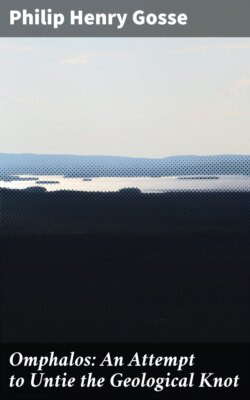Читать книгу Omphalos: An Attempt to Untie the Geological Knot - Philip Henry Gosse - Страница 3
На сайте Литреса книга снята с продажи.
PREFACE.
ОглавлениеTable of Contents
"You have not allowed for the wind, Hubert," said Locksley, in "Ivanhoe;" "or that had been a better shot."
I remember, when I was in Newfoundland, some five-and-twenty years ago, the disastrous wreck of the brig Elizabeth, which belonged to the firm in which I was a clerk. The master had made a good observation the day before, which had determined his latitude some miles north of Cape St. Francis. A thick fog coming on, he sailed boldly by compass, knowing that, according to his latitude, he could well weather that promontory. But lo! about midnight the ship plunged right against the cliffs of Ferryland, thirty miles to the south, crushing in her bows to the windlass; and presently went down, the crew barely saving their lives. The captain had not allowed for the polar current, which was setting, like a sluice, to the southward, between the Grand Bank and the land.
When it was satisfactorily ascertained that the heavenly body, now known as Uranus, was a planet, its normal path was soon laid down according to the recognised law of gravitation. But it would not take this path. There were deviations and anomalies in its observed course, which could in nowise be referred to the operation of any known principle. Astronomers were sorely puzzled to explain the irregularities, and to reconcile facts with laws. Various hypotheses were proposed: some denied the facts; that is, the observed places of the planet, boldly assuming that the observers had been in error: others suggested that perhaps the physical laws, which had been supposed to govern the whole celestial machinery, did not reach so far as Uranus's orbit. The secret is now known: they had not allowed for the disturbances produced by Neptune.
In each of these cases the conclusions were legitimately deduced from the recognised premises. Hubert's skilled eye had calculated the distance; his experience had taught him the requisite angle at which to shoot, the exact amount of force necessary, and every other element proper to insure the desired result, except one. There was an element which he had overlooked; and it spoiled his calculations. He had forgotten the wind.
The master of the ill-fated brig had calculated his latitude correctly; he knew the rate of his vessel's speed; the compass had showed him the parallel on which to steer. These premises ought to have secured a safe conclusion; and so they would, but for an unrecognised power that vitiated all; he was not aware of the silent and secret current, that was every hour setting him to the south of his supposed latitude.
The path of Uranus had been calculated by the astronomers with scrupulous care, and every known element of disturbance had been considered; not by one, but by many. But for the fact that the planet had been previously seen in positions quite inconsistent with such a path, it would have been set down as beyond controversy correct. Stubborn fact, however, would not give way; and hence the dilemma, till Le Verrier suggested the unseen antagonist.
I venture to suggest in the following pages an element, hitherto overlooked, which disturbs the conclusions of geologists respecting the antiquity of the earth. Their calculations are sound on the recognised premises; but they have not allowed for the Law of Prochronism in Creation.
The enunciation of this principle will lie in a nut-shell; the reader will find it at p.124; or p.347. All the rest of the book is illustration.
I do not claim originality for the thought which I have here endeavoured to work out. It was suggested to me by a Tract, which I met with some dozen years ago, or more; the title of which I have forgotten: I am pretty sure it was anonymous, but it was published by Campbell, of 1, Warwick Square. Whether it is still in print I do not know; I never saw another copy. If the author is alive, and if he should happen to cast his eye on this volume, he will doubtless recognise his own bantling, and accept this my acknowledgment.
The germ of the argument, however, I have found, since these pages were written, in "The Mineral and Mosaical Geologies," of Granville Penn (1822). The state of physical science when he wrote did not enable him to press the argument to a demonstration, as I have endeavoured to do; for he could not refer to structural peculiarities as sensible records of past processes, inseparable from newly created organisms.
I would not be considered as an opponent of geologists; but rather as a co-searcher with them after that which they value as highly as I do, Truth. The path which I have pursued has led me to a conclusion at variance with theirs. I have a right to expect that it be weighed; let it not be imputed to vanity if I hope that it may be accepted.
But what I much more ardently desire is, that the thousands of thinking persons, who are scarcely satisfied with the extant reconciliations of Scriptural statements and Geological deductions,—who are silenced but not convinced,—may find, in the principle set forth in this volume, a stable resting-place. I have written it in the constant prayer that the God of Truth will deign so to use it; and if He do, to Him be all the glory!
P. H. G.
Marychurch, Torquay,
October, 1857.
